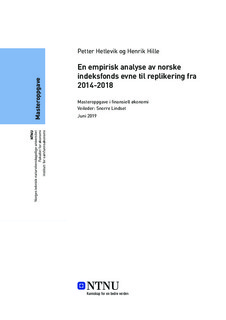| dc.contributor.advisor | Lindset, Snorre | |
| dc.contributor.author | Hetlevik, Petter | |
| dc.contributor.author | Hille, Henrik | |
| dc.date.accessioned | 2019-09-05T14:00:35Z | |
| dc.date.available | 2019-09-05T14:00:35Z | |
| dc.date.issued | 2019 | |
| dc.identifier.uri | http://hdl.handle.net/11250/2612750 | |
| dc.description.abstract | Formålet med denne utredningen er å vurdere norske indeksfonds replikeringsevne i perioden 2014-2018. Oppgaven vil vurdere om norske indeksfond klarer å levere avkastning lik markedet etter forvaltningshonorar, og hvilke faktorer som kan påvirke indeksfondenes replikeringsevne. Her vurderes både indeksfaktorer og fondsfaktorer, og om replikeringsevnen er forskjellige i løpet av året.
Vi benytter fem prestasjonsmål for å måle replikeringsevnen til norske indeksfond. Disse er absolutt differanseavkastning, relativ volatilitet, differanseavkastning, alfa og beta. De tre første måler hovedsaklig avvik mellom indeksfondenes avkastning og avkastningen til referanseindeksen, mens de to siste er risikojusterte mål og fungerer som en indikator på hvor passiv forvaltet indeksfondene er. Det blir kjørt flere regresjonsmodeller for å teste hvilke indeksfaktorer og fondsfaktorer som har signifikant påvirkning på replikeringsevnen til indeksfondene, og i hvilken grad replikeringsevnen er lik i løpet av året.
I utredningen blir det konkludert med at norske indeksfond i gjennomsnitt i perioden 2014-2018 ikke klarer å oppnå markedsavkastning etter forvaltningshonorar. Videre blir det funnet signifikante forskjeller i replikeringsevnen i løpet av året, da indeksfondene viser svekket replikeringsevne i perioden april til juli. Det blir til slutt konkludert i vårt studie at signifikante grunner til svekket replikeringsevne skyldes utbytteavkastning, forvaltningshonorar og kontantbeholdning. | |
| dc.description.abstract | The purpose of this master thesis is to evaluate Norwegian index fund´s ability to replicate their underlying benchmark index in the period 2014-2018. The thesis will evaluate if Norwegian index funds are able to deliver market return after management fees and which factors that can have an effect on their ability to replicate. Both fundfactors and indexfactors will be evalutated and if the ability to replicate differs during the year.
We will use five tracking errors to measure Norwegian index fund`s ability to replicate. These are abosolute difference in returns, relative volatility, difference in return, alpha and beta. The first three measures the aberrancy between the return of the index funds and the return of the benchmark index, while the last two are riskadjusted measurements and can be seen as an indicator on to which extent passive management are used by the index funds. Several regression models have been used to test which index factors and fund factors that have an significant effect on the ability to replicate, and to which extent the ability to replicate is the same through the year.
The conclusion is that Norwegian index fund in average in the period of 2014-2018 are not able to achive market return after management fees. We also found that there were significant differences in the ability to replicate during the year, where the index funds had a weaker replication in the months April to June. Our study shows that significant reasons to explain a weaker ability to replicate the benchmark index, are as follows: time difference in dividend payouts, management fees and the amount of cash held by the index fund. | |
| dc.language | nob | |
| dc.publisher | NTNU | |
| dc.title | En empirisk analyse av norske indeksfonds evne til replikering fra 2014-2018 | |
| dc.type | Master thesis | |
